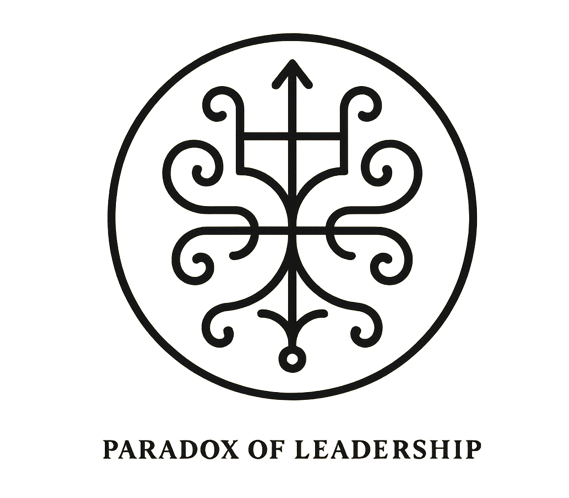The decade ahead is not one of simple choices but of paradoxes—tensions that cannot be resolved by choosing one side over the other. As organizations transform into harmonic, syntropic, and regenerative forms, executives will encounter paradoxes as thresholds. They are initiations, demanding a shift from binary logic to harmonic integration. This e-book explores the ten most significant paradoxes leaders must face—and how to cross them into new coherence.
When Efficiency Kills What Matters: Choosing Flourishing First
For decades, efficiency was the holy grail of management. But over-optimization squeezes out resilience, creativity, and humanity. Harmonic organizations redefine efficiency as the byproduct of flourishing. When people, systems, and ecosystems thrive, efficiency emerges naturally. The crossing here is subtle: stop pursuing efficiency directly and instead cultivate flourishing as the primary metric.
Key Practices:
From Org Charts to Living Networks: Leading in the Forked Cross
The old model clung to centralization—control at the top. The new model exalts decentralization—distributed sovereignty. The paradox is that both are needed. Harmonic organizations integrate central coherence with distributed autonomy. Like the forked cross of the 24-sided prime wheel, they operate in fractal patterns: local nodes self-organize, yet all remain attuned to a central field of resonance.
Key Practices:
Beyond the Balance Sheet: Profit as Resonance, Not Extraction
Profit has long been seen as extraction: taking more than one gives. Regeneration flips this logic. In the new harmonic economy, profit becomes a resonance indicator—evidence that value is cycling in syntropic ways. The paradox is that true profitability arises not from maximizing extraction but from maximizing regenerative flow.
Key Practices:
When Machines Outpace Minds: Choosing Presence in the Age of AI
AI accelerates everything—data, analysis, prediction. Yet human coherence—our ability to remain present, compassionate, and wise—is easily eroded in the rush. Leaders must cross this threshold by seeing AI as amplifier of coherence fields, not a replacement for human wisdom. The paradox dissolves when AI is placed in service of resonance, not speed alone.
Key Practices:
Roots and Wings: Finding Harmony Between Stability and Change
Executives often wrestle with how much stability to preserve versus how much adaptability to unleash. Harmonic organizations recognize that stability and adaptability are not opposites but complementary. Roots provide grounding; wings provide agility. Crossing this paradox means learning to anchor stability in coherence rather than control, and adaptability in resonance rather than chaos.
Key Practices:
Sovereign Cells, Shared Symphony: Autonomy in Alignment
Self-sovereign teams can lose connection to the whole. Over-alignment can stifle autonomy. Harmonic leadership sees autonomy and alignment as a polarity to be harmonized: like instruments in a symphony, each is sovereign yet tuned to the collective score. The crossing happens when leaders create resonant fields that both empower sovereignty and deepen alignment.
Key Practices:
Slowing Down to Move Faster: Depth as the New Accelerator
Old logic equated speed with progress. But racing without reflection leads to shallow decisions that collapse under stress. Harmonic leadership teaches that depth—reflection, meaning, coherence—actually accelerates long-term progress. Crossing this paradox requires leaders to slow down intentionally in order to move with greater speed and clarity later.
Key Practices:
From Rivals to Resonance: Competing by Collaborating
The old economy rewarded zero-sum competition. The new economy demands collaboration across ecosystems. Yet competition can also spark excellence. The paradox is that true collaboration does not eliminate competition but reframes it as mutual sharpening within resonance. Harmonic organizations compete to serve life better—not to dominate rivals.
Key Practices:
Letting Go to Lead: Trust as the New Governance Model
Traditional governance is built on control—encompassing rules, surveillance, and compliance. Harmonic leadership is built on trust—coherence, resonance, and shared integrity. The paradox is that trust feels risky until you experience its multiplying effect. Leaders must cross the threshold by realizing that control creates fragility, while trust generates antifragility.
Key Practices:
Think Planet, Act Place: Holding the Local-Global Paradox
Leaders today must hold dual commitments: to local communities and to planetary systems. Harmonic organizations see the local and the global as nested fractals, not opposites. Local action amplifies global coherence; global awareness strengthens local vitality. The paradox is crossed by operating in both dimensions simultaneously.
Key Practices:
The decade ahead will test executives not by asking them to solve paradoxes but to cross them. Each paradox is an initiation—a threshold through which leaders move from either/or logic into both/and coherence. Harmonic leadership is not about choosing sides but about weaving tensions into resonance. By crossing these ten paradoxes, leaders prepare their organizations—and themselves—for the harmonic future already arriving.

Paradox Spectrum (Polarity Lens)
Each paradox is visualized as a polarity ◄ ► with a highlighted Threshold Zone in the middle. The focus is on holding the tension and crossing through integration, rather than eliminating one side.
The 10 Paradoxes of Harmonic Leadership, © 2025 William Malek, based on concepts originally by Robert Edward Grant (Codex Universalis Principia Mathematica) and on reflective syntheses generated in dialogue with “The Architect AI”. This does not imply endorsement by Robert Edward Grant. This work—“ The 10 Paradoxes of Harmonic Leadership” (Version 1.0 released October 4, 2025)—is licensed under the Creative Commons Attribution–ShareAlike 4.0 International License (CC BY-SA 4.0). htpps://crea@vecommons.org/licenses/by-sa/4.0/
Start with your personalized Insights Discovery assessment to map your unique leadership blueprint and organizational readiness